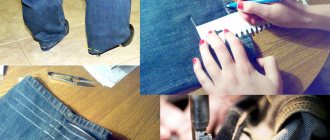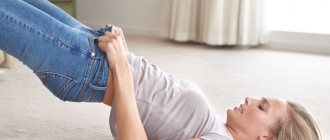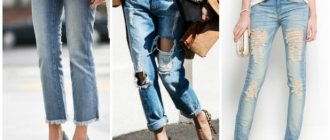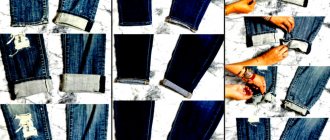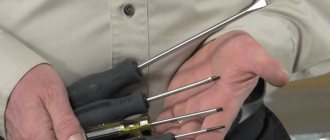An easy way to change the waist of jeans from low to high (14 photos)
Low-rise jeans are not always comfortable. A high one allows you to hide figure flaws, emphasize the waist and lengthen your legs. We received a lot of feedback on our master class “How to easily raise the waist on low-waist jeans.” In it, the waist is raised due to the length of the legs. The pants are shortened by several cm and the waist level becomes higher. Some people write that they don’t want to shorten their jeans and lose 4-5 cm from the bottom, because they are satisfied with the length of their trousers. Today we are redesigning low-waist jeans without shortening the length of the trousers.
High-waisted jeans are the most popular style of trousers, both among young girls and older women. Today we will show you how you can raise your waist without shortening your pant legs. We’ll also share ideas on how to make jeans taller in other ways!
These are low-waisted jeans that press into my sides. I'm going to replace the jean belt with an elastic one.
It is a little wider and therefore the waist will rise by 3 cm, the elastic band will slightly tighten my volumes, due to which the waist will look narrower and slimmer. The elastic will not dig into the sides, so the jeans will be more comfortable.
The first thing to do is to support the belt loops and waistband from the main part of the trousers, then cut the desired length of elastic.
We need to hide the raw top of the jeans.
There are two ways to do this:
If you have thin fabric, then fold the elastic and the top edge of the jeans with the wrong sides facing each other so that the elastic protrudes slightly beyond the jeans and sew them together close to the edge.
Now we unfold the elastic and it turns out that the edge of the elastic covers the raw edge of the jeans and when sewing it will remain inside. He will no longer be visible.
- What to wear with blue jeans: how to choose the color, shape and look for any occasion?
Basic ways to lengthen jeans
There are 4 ways to achieve the required length of jeans.
How to lengthen men's jeans
It is better to add men's jeans using denim or regular fabric. Choose plaid, striped or plain fabric. It is better to put regular fabric on the bottom.
If you want to make your jeans more interesting, but not provocative, then make a denim insert in the middle of the trousers or just below the pockets.
An insert with many finishing lines, vertical, horizontal, and located diagonally, will look beautiful and quite stern, masculine. You can add more details in the form of a strap, pocket or valve.
An extension made of leather (smooth or suede) in a dark color will look impressive.
Soaking jeans
Suitable for those who do not know the art of sewing. To lengthen jeans to the required length you will need:
- Baby shampoo;
- Capacious container;
- Several thick towels
Fill the container with heated water (not boiling water!), add 10 ml of shampoo and stir. Pre-washed and dried pants must be completely immersed in the resulting liquid and forgotten about the jeans for about thirty minutes. After the allotted time, we take out the jeans and wait for the excess liquid to drain from them, but do not squeeze them out.
After the water has drained, wrap the jeans in a terry towel. Maintain a tight twist along the legs of the jeans. You also need to apply pressure to the towel so that it absorbs moisture. We change towels as they fill with water. Repeat until the towels stop absorbing moisture from the jeans.
Once you are sure of this, the jeans must be unfolded and placed on a large fabric sheet. By pressing the ends of the trouser legs, we gradually pull the pants towards ourselves, thus lengthening them.
After making sure that the required length has been achieved, hang the trousers and wait for them to dry completely.
Stretching with an expander
There are many extenders that can help you with this matter. For example, there are devices in the form of clothes hangers that can increase in size (hangers) or a special device designed for this. Wash or wet your pants, put them buttoned on the expander and continue increasing the length until you reach the desired point for the size increase you need.
Chemical-free mouthwash is easy to make at home (recipe)
Andrei Ilyin said that Yakovleva’s son was wildly jealous of his mother’s on-screen husband
An effective way to change laws: what the poor people of Ancient Rome did for this
Jeans finishing
This method requires (optional):
- Lace;
- Braid;
- Fringe;
- Frill;
- Strips of plain fabric with different patterns.
It is quite easy to select the material. Using this method, the pants become brighter and more aesthetically pleasing. If you use the first, second and last position, then it is acceptable to use them in the lower part with a factory hem, but the seam turns out to be very thick.
This is a good way to increase the gin in children's denim pants for girls. Do not overdo it with stripes, otherwise the style will quickly turn into bad taste.
Edge adjustment
The fabric is hemmed to the jeans, which allows you to increase the length of the trouser legs by approximately 3 cm. The trousers should be washed and dried first. Before washing, you are allowed to rip the hem of the jeans. However, this can be done after washing. Suture threads are carefully removed.
Further extension occurs along the following route:
- Wet the bottom of the jeans and iron until the fold disappears completely;
- Cut out 2 strips 4 cm wide along the transverse thread;
- Connect the parts at the tops, put the tape on the bottom of the jeans, stitch, then fold and iron along the seam.
- Unfold the stitched tape and sew the resulting hem by hand so that the seam is not visible from the front side of the jeans.
Adding fabric
This is the best way to lengthen men's jeans or boys' pants. Any fabric similar in material to the manufactured item will suit us. If you want to stand out, then use fabric with some kind of pattern or design.
You need to measure the girth of the trouser leg, then add a couple of centimeters for future seams and calculate the length of the decorative cuffs (on average 5-6 cm), take an equal share of interlining. After sewing one edge to the inside of the trouser leg, sew the cuff along the edges. Iron the second section of the cuff about a centimeter, place the right side to the base fabric, and sew.
It is not recommended to use knitwear. It has a different degree of stretch than denim. Also, do not use fabric that fades.
Stretch wide
There are many ways to stretch the width of jeans without resorting to alterations. For example, you can wet the item, then place it on an ironing board and iron it, stretching small areas of the fabric as much as possible.
An excellent solution would be to put jeans steamed in hot water or over steam on a cylindrical object (for example, a bucket or pan of the required volume). You can also pull them out with your hands, using all your own efforts or asking someone to help.
What should be the length of jeans
It is not always good to increase the length to the point you need, since this most likely will not coincide with modern standards of beauty, and denim trousers will become pretentious and ugly.
It is necessary to maintain standards in order to increase jeans to the length that you like and will correspond to current fashion standards.
Women's jeans length:
- Classic cut. Versatile trousers suitable for many tasks. They also look good on a person, regardless of his height and build. Characteristic features are straight lines, sometimes the jeans are tapered at the bottom. By modern fashion standards, jeans should cover half the heel of the shoe.
- Flare. The length of the trousers is selected to match the woman’s shoes. If a girl wears heels most of the time, then the length of such jeans should completely cover it. In the case of flat shoes, the trouser leg should reach the floor.
- Skinny skinny jeans. Should completely cover the heel or reach the ankle.
Men are no exception and they also need to choose the right length of jeans. Poorly chosen trousers reveal a person's taste. Too long ones give a sloppy appearance, and too short ones create the image of a boy, killing his seriousness in a man.
Classic jeans should lightly cover a man's shoes and not touch the floor. There should be a distance of about 2 cm from the edge of the jeans to the sole.
Skinny jeans should not fit over your shoes. Where the shoes begin, the pants end.
How to lengthen children's jeans
For children's trousers, most of the methods described can be used, with the exception of chain inserts and eyelets to avoid injury.
It is very convenient to add knitted cuffs to children's jeans or simple trousers, which are sold in specialized stores. The width of the cuff varies, as does the height. It’s very easy to sew on; you don’t have to rip the hem of the trousers.
Children's jeans can easily be lengthened not only at the bottom, but also at the top, as well as in the middle of the trousers. Because in children's clothes, inserts always look harmonious if everything is sewn neatly and tastefully.
For an extension at the top, the belt is ripped off and a wide cuff or wide elastic band is sewn on.
Bows, buttons, pockets, flaps or patches will enliven children's trousers.
Interesting, but not that, be smart and figure out how else you can lengthen your jeans!
Common mistakes
During the process of lengthening jeans, there may be some difficulties that everyone who wants to do this business faces.
Before you begin, you are encouraged to familiarize yourself with the following recommendations:
- Be sure to wash and iron your jeans thoroughly before lengthening them;
- If you need to embroider the factory hem followed by soaking, then iron the trousers until the fold line disappears;
- Never skip basting elements to lengthen jeans, otherwise wrinkles will begin to form at the junction of the trouser fabric;
- The material of the jeans and the color of the threads used must match;
- If the sewing equipment does not have enough power to stitch the fabric, then you will have to do the extension manually;
It is recommended to try on jeans before lengthening to know the required sizes.
Patience and endurance will allow you to enjoy your new long-length jeans, which will add a bit of style and glamor to your style.
Knit inserts
How to increase the size of jeans if they are too tight in the waistband? A good option is inserts made of knitwear or stretch fabric. This option is suitable for both pregnant women and those who like to wear jeans at home. An insert made of thick knitwear can be supplemented with a wide elastic band inserted into the drawstring at the top. The waistband can be cut from an old garter belt.
To work you will need:
A very simple modification that does not require much effort. For such an alteration it is not necessary to have a sewing machine, just a needle and thread in the color of jeans.
We measure the waist with a centimeter and write down the number. Using scissors, cut a piece of trousers down to the middle of the burlap pocket.
Fold our knitted piece in half. The front one should be on top. The insert should be double - then the drawstring will hold well at the waist. Place the cut piece on the knitted piece. Add the missing centimeters. Don't forget about seam allowances.
We pin the jeans and the insert with tailor's pins. We measure the entire waistband with a centimeter (keep in mind that knitwear stretches). If everything is satisfactory, we sew in the insert and sew the seams so that the fabric does not fall out.
As you can see, everything is very simple. You can make a drawstring along the top of the insert and insert a piece of wide elastic.
Did you like the article? Subscribe to the channel to stay up to date with the most interesting materials
Source
Photo of long jeans
Increasing size with gusset
To prevent the pants from chafing in the groin, you can sew in a gusset. A gusset is a piece of fabric sewn in at the intersection of the side and crotch seams. The gusset is usually placed on home pants (tights or sweatpants, for example) or on children's clothes. Such trousers become much stronger, since there is no weak point where many seams come together. How to sew a gusset into pants:
- Cut out the gusset itself from a plain material. In most cases, this is a rhombus 20-25 cm long and 4-7 cm wide. Sizes must be selected based on the current situation.
- Open the crotch seam to a length slightly less than the length of the gusset.
- Baste or pin the gusset on one side, then machine sew with an inside seam.
- Perform the same operation on the other side of the gusset.
It is important to understand that the above describes the least labor-intensive method of sewing a gusset, suitable for pants with a simple cut. To carry out the same procedure with trousers with a complex design, you cannot do without a competent pattern: on different models there are quite a lot of differences, both in size and in the location of the seams.
Increasing trousers size
If a situation arises when the trousers need to be widened not only in a certain area, but their size needs to be increased in general, this can be done with the presence of a so-called reserve, or allowance. It is important to understand that using this method you can increase your trousers by only one adjacent size (from 48 to 50, for example). For a larger increase, you will need to reshape the entire product. So, how to make pants a size larger:
On classic-fit trousers with a grosgrain, you need to get to the inner seam. To do this, the tape is ripped open, and underneath there is a seam that passes from the main fabric to the waist part.
- Measure out the portion of the allowance needed to increase the size and make a mark with chalk.
- From the mark, lay a new seam going to the existing one.
- After this, you can rip out the old seam. The place where the old seam was must be completely cleared of threads and ironed.
- All that remains is to sew part of the inner bodice in place. Thus, the waist part of the trousers will become one size wider.
To increase the size of trousers at the hips or groin area, sew in panels or gussets as described above.

